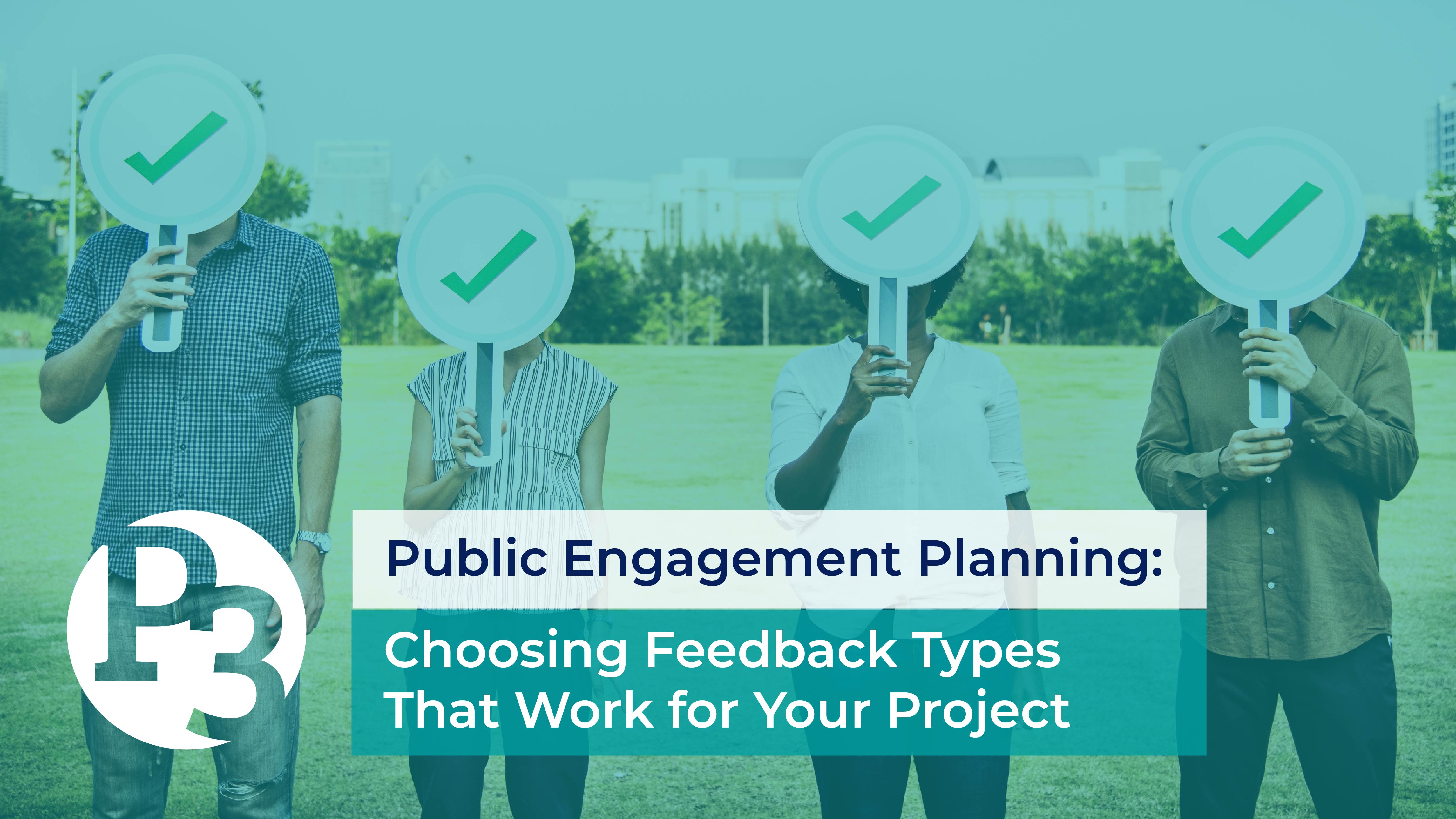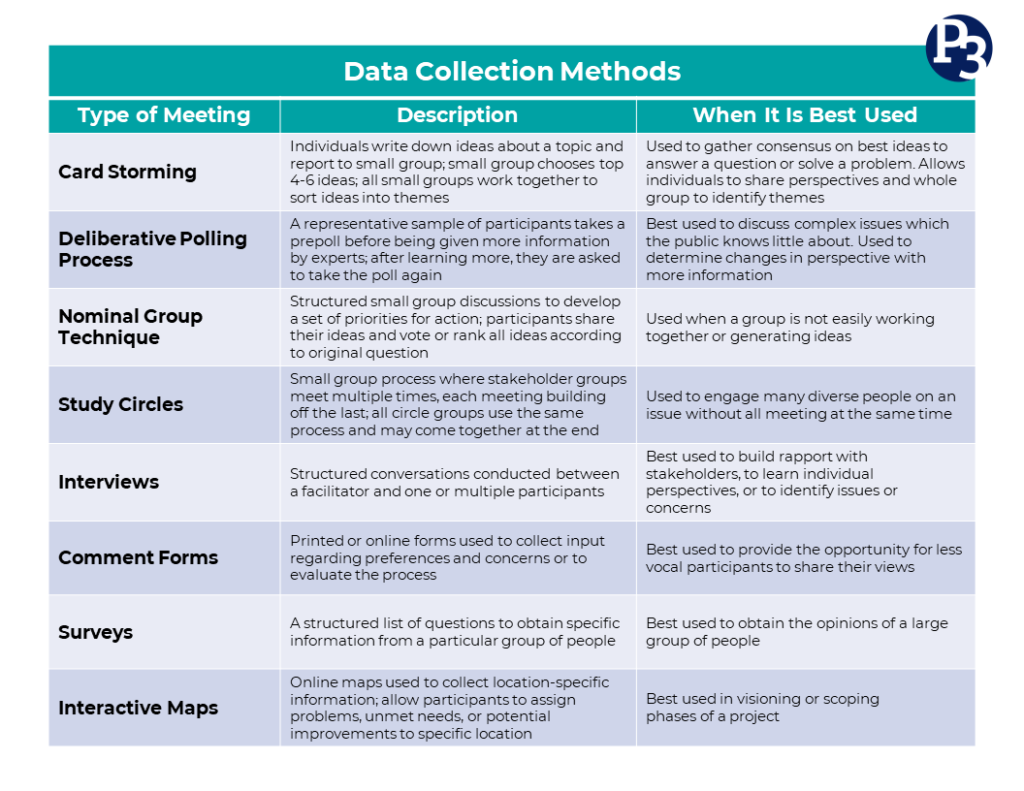
12 Nov Public Engagement Planning: Choosing Feedback Types That Work for Your Project
In our last post, we discussed the importance of public meeting planning and choosing options that work best for your stakeholders. But once you host a meeting, how do you collect feedback from participants? How can you ensure that community members have the opportunity to share their opinions and make their voice heard? And how do you make sure the feedback you are gathering is quality data that can actually be used in the decision-making process?
Planning what feedback methods you will use is an important step in your overall engagement process. Certain methods will work better depending on your meeting type, audience, and goals during a project phase. Your project budget, available time, and resources will also factor into your feedback strategy.
You may choose to collect feedback through interactive group methods, such as card storming or study circles, or individual methods, such as interviews or surveys. Interactive feedback methods allow members of the community to discuss and work together to provide input and voice concerns, whereas individual feedback stems from a single person. It may be best to use a combination of methods to ensure that you are getting a large amount of high-quality feedback to help shape decision-making.
First and foremost, it is important to determine what information you are trying to gather from the public. It is also important to remember what level of influence the public has in decision-making (remember the IAP2 Spectrum of Participation?!). These will factor into your feedback strategies and provide guidance on selecting the best methods to collect data.
Here are some tips to keep in mind for planning data collection methods and collecting public feedback.
Ask yourself what you are trying to gather feedback on.
It is important to know what information you need from the public before deciding on a feedback method. Some methods are better for collecting certain types of input. The chart below highlights specific data collection methods and when they are best used:

Knowing the type of data you need is a crucial step in planning your data collection strategy. This way, you are able to select methods that will create appropriate and relevant data to help guide your decision-making.
Consider your audience and choose methods that will work best for them.
Consider your audience and stakeholders when developing a strategy for data collection. Remember to account for general age of the community, means of access to technology, regular time commitments, and more. For example, if your stakeholders are in a rural area without reliable access to Internet connection, having exclusively virtual methods of providing feedback may not be effective. If your audience is largely working adults, consider methods where they can provide feedback on their own time instead of through structured meetings.
Recognizing community attributes and planning data collection with them in mind not only ensures more people will participate, but also emphasizes consideration for community members. Utilizing methods that are more convenient for them will show an appreciation for their involvement and an understanding of what they need from you as an agency.
Understand the required resources needed for selected methods.
Remember to factor in resource, staffing, and budget constraints when selecting feedback methods. While some methods may be favorable to you, they may not be feasible with what you have to work with. Remember that in-person feedback collection will require more staff presence and consider how that fits into your project budget. If you are using an online survey, consider the cost of the platform you will use (if there is one) and the resources needed to create it.
Keep these constraints in mind to create more realistic data collection expectations for yourself and create a feedback strategy that will work best for your project.
Create a method to keep track of data throughout the feedback collection process.
It is crucial to have a database or system in place to collect and store feedback. Otherwise, all of the data you gather may get jumbled together or lost completely and be unable to be used for decision-making. We recommend using a data collection software or similar method to keep track of all comments and feedback received. It is also important to distinguish when you received that comment –separate sheets or files for each public comment period may be helpful!
You should keep track of every comment and all feedback received. If the data collection process is virtual, such as through an online survey, it is easy to have a record of what everyone says. However, if you are collecting feedback in person, remember to take notes or record the conversations (with permission) to refer back to later. Having all feedback documented can increase transparency and serve as justification for decision-making. Data collection can provide insight as to why certain decisions were made, so it is best to keep a record!
Keep track of demographics throughout the feedback collection process.
Whether collecting feedback in person or virtually, it is important to keep track of the demographics of those participating and compare that to your study area as a whole. This will be a useful tool in your equity analysis and allow you to make sure you are reaching a representative sample of the study area population.
What are some good things to keep track of? This may vary slightly depending on the project area’s demographics and your engagement goals, but a good standard set of demographics to keep track of includes: racial identity, gender identity, age, annual household income, and English proficiency.
Spread the word! Promote your feedback methods to the community.
Once you decide on your data collection methods, it is important to get the word out there and let the community know! Otherwise, no one would be able to participate and your data would not be representative or incredibly useful. Spread the word and gather as much feedback through your chosen methods as possible!
How do you effectively reach the community? Need tips on planning a communication strategy? Stay tuned for our next blog post…
Planning a feedback strategy can be daunting, but it is incredibly important. After all, collecting input from the public is the goal of community engagement! We hope these tips provide a foundation for collecting quality and representative feedback that can be used to influence decision-making.
Once you have your feedback types selected, it’s time to get the word out! Stay tuned for Part 3 of our Public Engagement Planning series to uncover tips on how to effectively communicate with your community.
TL;DR
About the Author: Katie Maynard started her journey with Public Participation Partners as a Community Engagement Assistant in January 2020. When not assisting with public involvement, Katie enjoys reading, traveling to the beach, and spending time with her pets.


Johnetta Perry
Posted at 14:31h, 13 NovemberGreat job!